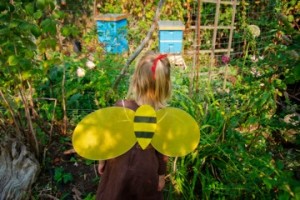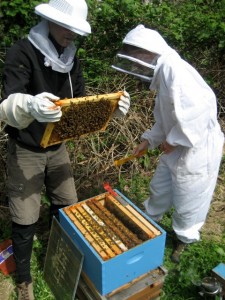Beekeeping
Maple Community Garden has two hives of honey bees. We also have beekeepers who are responsible for tending the hives and ensuring the queens and bees stay healthy. Since colonies must be a certain size to reproduce, sometimes a queen will opt to start another colony by a process called ‘swarming’.
Swarming is the natural means that honey bees use to expand their colonies. In the process of swarming, the queen bee leaves the colony with a large group of worker bees [~60% of the original colony] and forms a new colony. This mainly happens in the spring, but occasionally swarms can happen throughout the producing season. Although a swarm of bees sometimes frightens people, the bees are usually not aggressive at this stage of their life cycle as they are focused on finding a new nesting location for their queen. Most bees will only attack in response to intrusions against their colony. If you happen to see a swarm of bees in the vicinity of Maple Community Garden there is no way of knowing where they came from, but please email info@malachimckann.ca so that the beekeepers can capture and install the swarm in a new hive.
It is important to keep the bee colonies healthy and well fed during all the seasons of the year, particularly in the late fall through to early spring [since mid-season plants are more plentiful]. Members can help by keeping some of the bee’s favorite food growing in each plot 🙂
Here is a list of some of the plants that bees are most attracted to:
| Early | Mid-season | Late |
| Blueberry | Blackberry | Aster (perennial) |
| Cotoneaster | Cat mint | Beggar’s tricks |
| Crab apple | Catnip | Borage |
| Cranberry | Chives | Coneflower |
| Crocus | Dahlia | Cornflower |
| Foxglove | Hyssop | Cosmos |
| Heliotrope | Lavender | Goldenrod |
| Hazelnut | Raspberry | Pumpkin |
| Heather | Sunflower | Sedum |
| Primrose | Yarrow | Squash |
| Willow Currant |
||
This website also provides a great overview of many bee-friendly plants by season, with photos:


